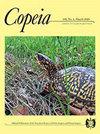Egg Clutch Survival under Prolonged Paternal Care in a Glass Frog, Hyalinobatrachium talamancae
IF 2.6
Q2 Agricultural and Biological Sciences
引用次数: 1
Abstract
Previous studies have reported egg attendance as the most common protective behavior among the Neotropical frog family Centrolenidae. However, research on the effect of parental care and other factors thought to affect offspring survival is still missing for a great number of species. Here, we performed field observations during day and night to associate male-only care, habitat characteristics, and environmental variables with egg clutch survival in the understudied glass frog, Hyalinobatrachium talamancae. We conducted 34 nest survival models for 39 egg clutches considering constant daily survival rates, temporal variation in the survival probability, and other biotic and abiotic variables thought to affect the survival of embryos. We found that egg attendance was strongly associated with egg clutch survival in H. talamancae. Our results showed similar degrees of parental investment during day and night, accounting for extensive caring periods over one or multiple clutches as paternal care did not hinder re-mating in this species. Egg clutches exhibited daily survival rates of 0.93±0.02, often reaching pre-hatching stages when attended by males. Our results may thus suggest that egg attendance is a major, if not predominant, determining factor of embryo survival in H. talamancae. This study contributes to the understanding of the natural history associated with paternal care in H. talamancae and provides insight into the evolution of prolonged male-only care in the family Centrolenidae.玻璃蛙talamancae的卵离合器在长期父系护理下的存活
先前的研究表明,产卵是新热带蛙科中最常见的保护行为。然而,对于许多物种来说,关于父母照顾和其他被认为影响后代生存的因素的影响的研究仍然缺失。在这里,我们在白天和晚上进行了实地观察,将研究不足的玻璃蛙Hyaliobatrachium talamancae的雄性护理、栖息地特征和环境变量与卵离合器存活率联系起来。考虑到恒定的日存活率、存活概率的时间变化以及其他被认为影响胚胎存活的生物和非生物变量,我们对39个卵窝进行了34个巢存活模型。我们发现,在塔拉曼卡线虫中,卵的存在与卵离合器的存活密切相关。我们的研究结果显示,父母在白天和晚上的投资程度相似,这解释了一个或多个离合器的长时间照顾,因为父亲的照顾不会阻碍该物种的重新交配。卵离合器的日存活率为0.93±0.02,当雄性参与时,通常达到孵化前阶段。因此,我们的研究结果可能表明,卵的存在是塔拉曼卡线虫胚胎存活的一个主要决定因素,如果不是主要的话。这项研究有助于理解塔拉曼卡蛛与父亲护理相关的自然史,并深入了解中央螺科长期仅男性护理的演变。
本文章由计算机程序翻译,如有差异,请以英文原文为准。
求助全文
约1分钟内获得全文
求助全文
来源期刊

Copeia
生物-动物学
CiteScore
2.10
自引率
0.00%
发文量
0
审稿时长
6-12 weeks
期刊介绍:
Founded in 1913, Copeia is a highly respected international journal dedicated to the publication of high quality, original research papers on the behavior, conservation, ecology, genetics, morphology, evolution, physiology, systematics and taxonomy of extant and extinct fishes, amphibians, and reptiles. Copeia is published electronically and is available through BioOne. Articles are published online first, and print issues appear four times per year. In addition to research articles, Copeia publishes invited review papers, book reviews, and compiles virtual issues on topics of interest drawn from papers previously published in the journal.
 求助内容:
求助内容: 应助结果提醒方式:
应助结果提醒方式:


